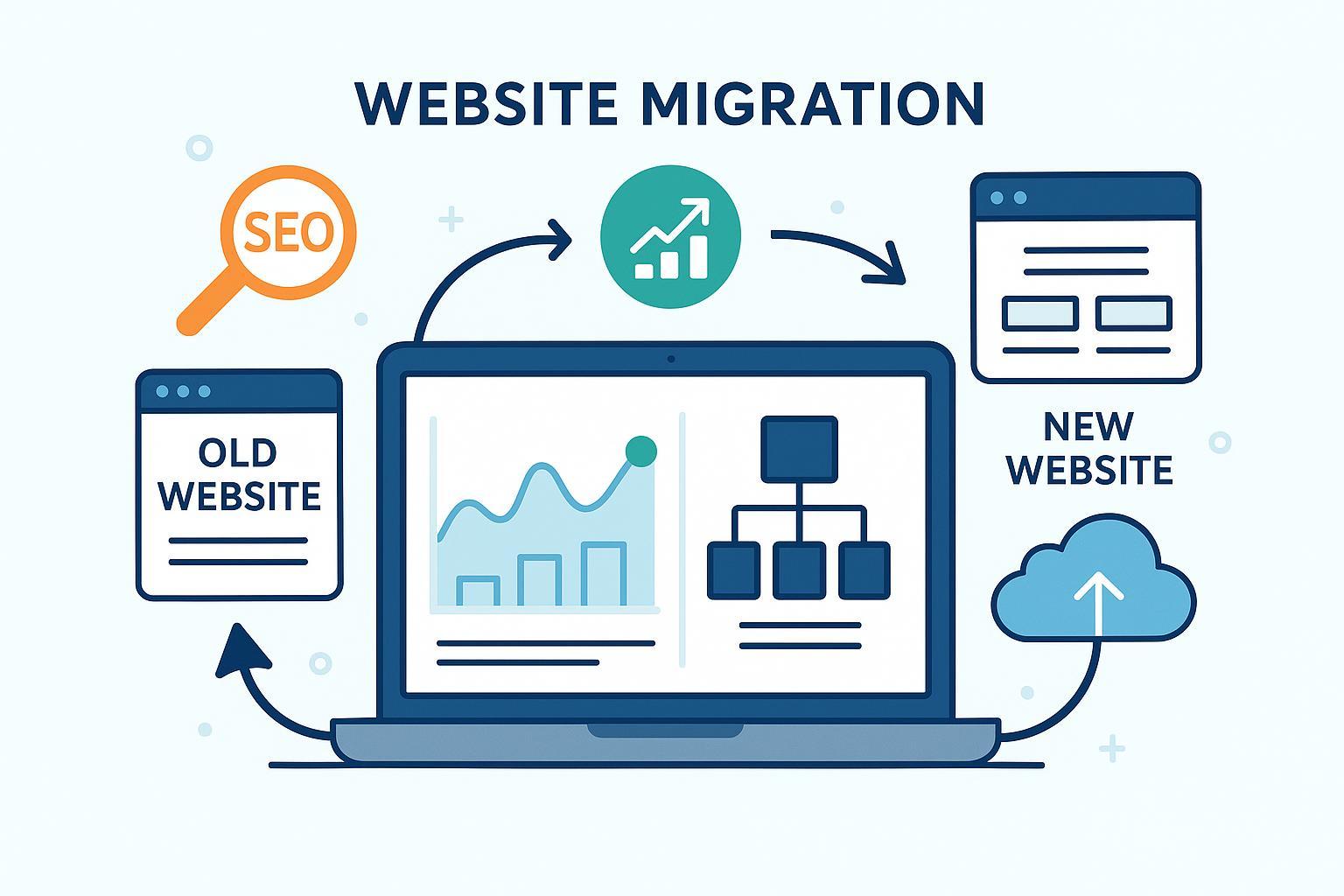Essential Website Migration Checklist: Key Steps to Ensure SEO Success

Website migration is one of the most high-stakes operations in digital marketing—get it right and your growth continues smoothly; get it wrong and your search rankings, traffic, and revenue can plummet overnight. This comprehensive checklist, built on leading industry guidance (SEMrush, Moz, Ahrefs, Search Engine Land, Lumar.io), walks you step-by-step through every decision and task necessary to safeguard your site’s hard-won SEO equity.
Scope Note: This checklist focuses strictly on website migrations affecting SEO (such as domain/platform/CMS moves or large-scale structure changes) and does not cover pure content redesigns or branding-only launches.
🎯 Why Use This Checklist?
- Guard your search visibility: More than 70% of migration failures stem from avoidable SEO oversights (Ahrefs).
- Prevent catastrophic losses: Missing redirects or improper indexing can erase years of SEO work in hours.
- Ensure phased, error-free delivery: Each step is broken by phase and risk, so nothing gets left behind.
✅ The Ultimate Website Migration SEO Checklist
Preparation Phase (4–8 Weeks Before Launch)
- Define clear migration goals and scope. (E.g., Are you changing domains, platforms, or major architecture?)
- Assemble the full migration team: Include SEO specialists, developers, UX, content, and project lead.
- Benchmark current site KPIs: Record rankings, traffic, conversions, backlinks—a baseline for detecting post-migration drops.
- Conduct full URL and asset inventory: Crawl your site (using Screaming Frog, SEMrush, Ahrefs, etc.) to map every accessible URL and file.
- Backup entire website, database, and media assets. (Non-negotiable safety step for rollback!)
- Map all redirects: Build a comprehensive 301/302 redirect spreadsheet old → new (covering pages, media, downloads, and orphan URLs).
- Document key backlinks/inbound links: Identify top-performing links for special attention/double checks.
- Audit and list all scripts, analytics, pixels, and tag managers.
- Review/update all SEO metadata: Prepare for title, meta, schema, canonical, and hreflang parity in new environment.
- Freeze content changes: Implement a no-edit period on the current site 1 week pre-migration (especially vital for high-content/enterprise sites).
Expert Tip: Moz recommends engaging all stakeholders early—gaps in communication are a leading cause of migration calamities.
Pre-Launch / Staging Environment
- Copy site to a staging/test environment: Ensure it mirrors live hosting, structure, and features.
- Block staging from search engines: Use robots.txt and/or noindex meta tags to prevent duplicate content/accidental indexation.
- Perform technical SEO audits on staging: Crawl for redirect logic, canonical errors, duplicate content, speed, schema, and Core Web Vitals.
- QA content, navigation, forms, and media: Confirm parity with the current site.
- Test all mapped redirects: Verify every legacy URL properly routes to its new counterpart—never default all to homepage!
- Migrate and test analytics/tracking scripts: Confirm that all events, conversions, and scripts are firing as intended.
- Prepare updated XML sitemap and robots.txt: Ready for go-live.
- Run checks for internationalization: Confirm hreflang tags, local URLs, and locale settings are correct (for multilingual/global sites).
Common Pitfall: Failing to block staging means Google could index your test site, causing duplicate content headaches post-launch (Lumar.io).
Migration / Launch Day
- Double-check backups and rollback plan: Validate database and file backup integrity and ensure all DNS/hosting details are ready.
- Remove all search engine blocks from the new live site.
- Switch DNS or update hosting as per finalized go-live plan (ideally during low-traffic hours).
- Monitor real-time for errors: Watch for 5xx, 4xx, redirect chains, and site speed drops.
- Verify all priority pages: Check navigation, conversion paths, contact forms, and scripts on key money/landing pages immediately post-launch.
- Submit the new XML sitemap and robots.txt to Google Search Console and Bing Webmaster Tools.
- Smoke-test main redirects, schema, and analytics tags on live URLs.
Pro-Tip: Use tools like Screaming Frog or Ahrefs Site Audit for immediate after-launch crawls and reports.
Immediate Post-Migration QA (First 48 Hours)
- Recrawl the live site with multiple SEO tools: Check for missed or broken redirects, stray 404s, and content parity.
- Confirm analytics and tracking are receiving new data.
- Update and validate site-wide internal links: Fix any references to legacy URLs in navigation, breadcrumbs, or in-page links.
- Resubmit XML sitemap (again if any update is made) and monitor for indexing in GSC.
- Check that schema, hreflang, and canonicals are in place and accurate.
- Inform Google and Bing of the migration: Use GSC’s Change of Address tool (if changing domains).
- Outreach to update critical external links: Contact top linking sites to update URLs if feasible (especially key partners, directories, ad campaigns).
Ongoing Monitoring & Optimization (First Month Post-Migration)
- Monitor keyword rankings, traffic, and conversion KPIs every single day for the first 2–4 weeks.
- Investigate any sharp or sustained ranking/traffic drops: Identify root causes via logs, crawl reports or server errors.
- Regularly recrawl for missed redirects and new sitemap errors.
- Continue watching for errors in Google Search Console and Bing Webmaster; address promptly.
- Report outcomes and lessons learned: Share a migration report/dashboard with all stakeholders; document next steps and optimization opportunities.
- Maintain rollback and fix plan for at least one month in case of severe post-migration failure.
💡 FAQs: Website Migration & SEO
Q1: Can I skip steps if it’s a small site or just changing the theme?
For minor theme changes with no URL or platform shift, some steps may be reduced—BUT doing keyword, analytics, and quick redirect checks is still a must for peace of mind.
Q2: What’s the most common migration SEO mistake?
Not mapping redirects for EVERY legacy URL, especially orphaned pages, PDFs, images, and landing pages. One missed redirect can tank key rankings.
Q3: Is there a zero-risk way to migrate?
Unfortunately, no—there is always some risk, but following this full checklist minimizes the chances of serious SEO loss. For critical sites, test first with a low-risk subdomain or section before a full-scale rollout.
Q4: How soon should I expect rankings to stabilize?
Usually within 2–6 weeks, assuming all steps are carried out. Short-term volatility is normal, but extended drops indicate technical or mapping problems.
💼 Mini Case Study: A Preventable SEO Disaster
A major retailer’s domain migration went live without a full redirect map—hundreds of category and product pages returned 404 errors. Their organic traffic dropped by 55% within 48 hours (source: Lumar.io failure cases). If they had used this checklist, every URL would have been mapped and tested. Recovery ultimately took six months—don’t repeat this mistake!
🚀 Download & Use This Checklist
- Download this SEO Website Migration Checklist as a printable PDF
- Access an editable Excel redirect mapping template
- Tip: Consider creating an internal Google Sheet/Notion doc for real-time team tracking and progress marking.
🏁 Final Word: Move with Confidence!
By methodically following these steps, you ensure your website migration proceeds smoothly, preserves your SEO value, and avoids costly disasters. Remember—migrations are rarely forgiving of shortcuts. If you’ve checked every box here, you’re ready to make your relaunch a true SEO success. Good luck!

